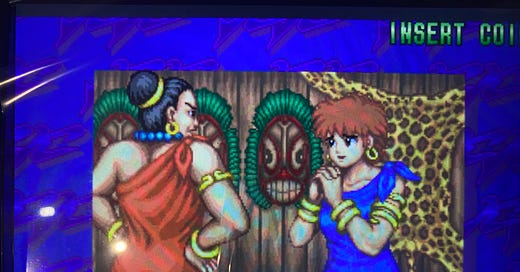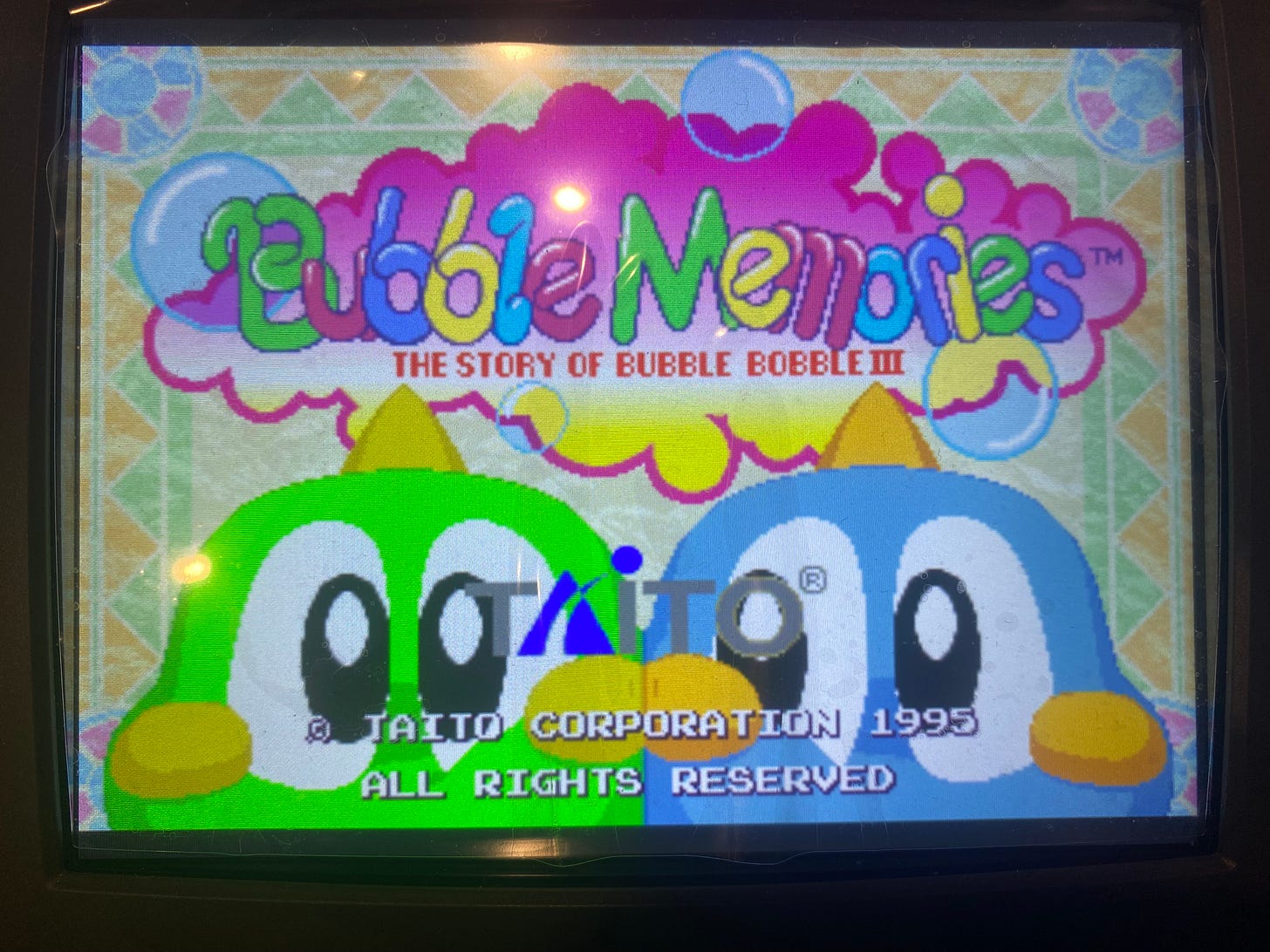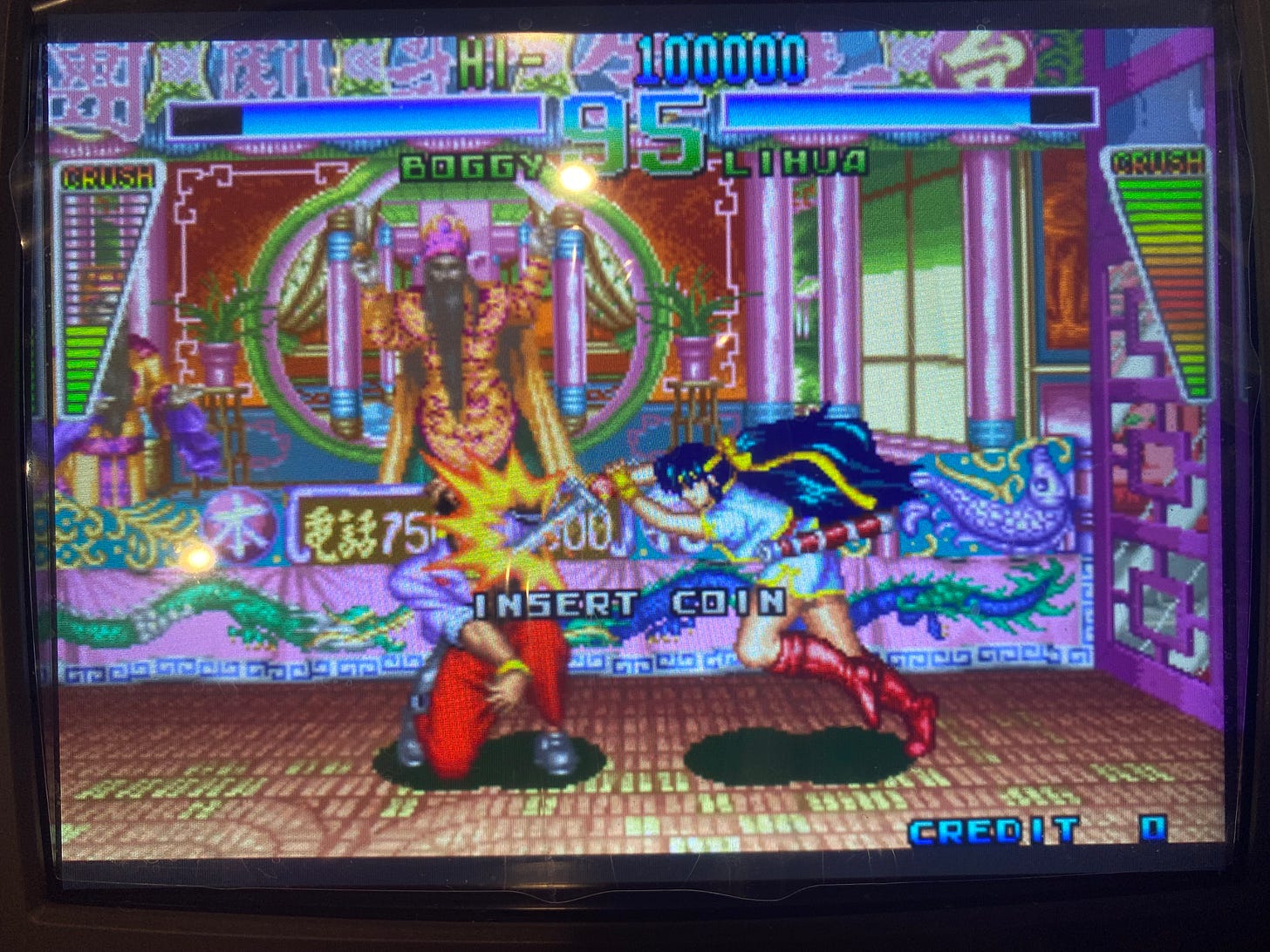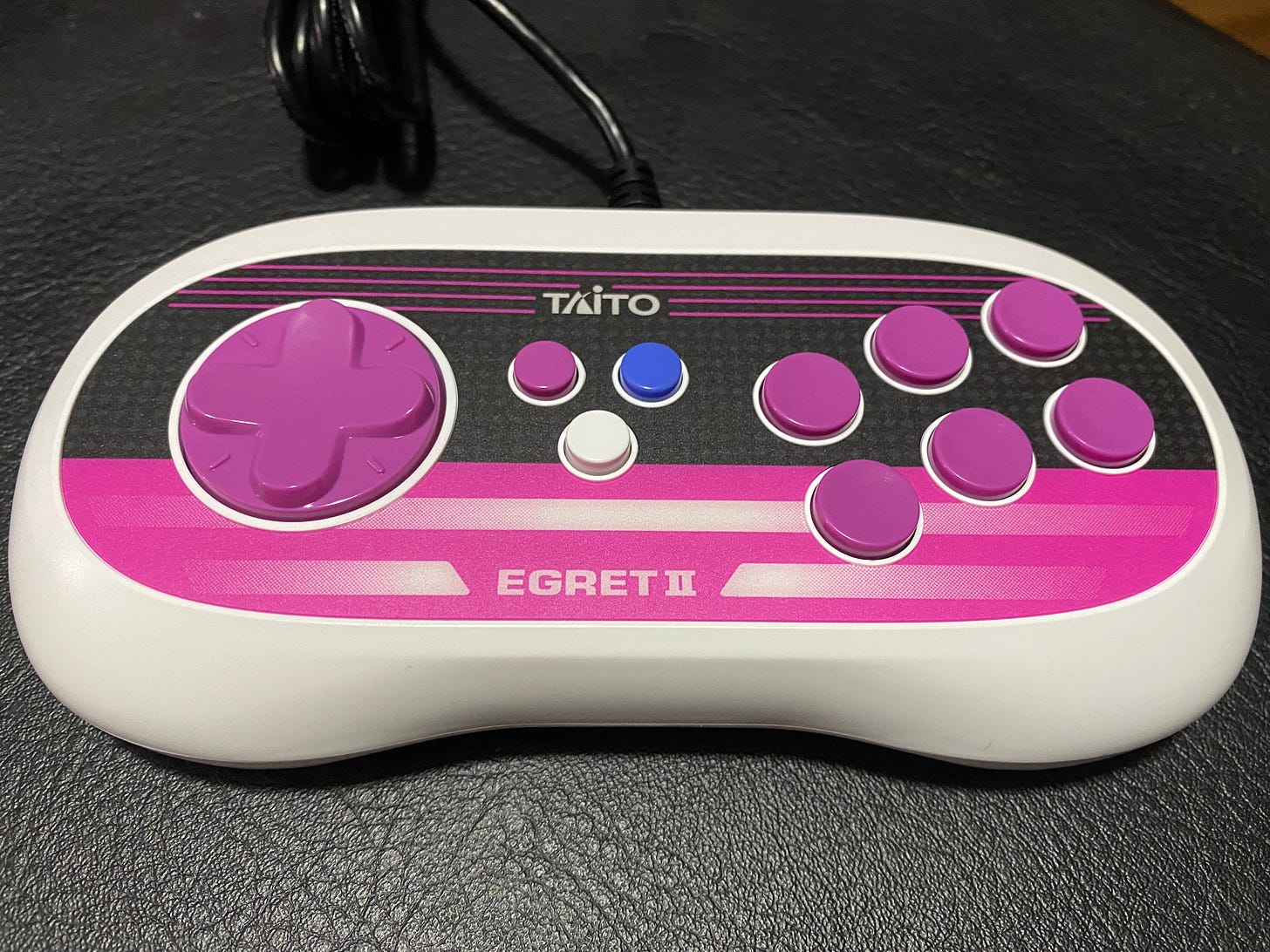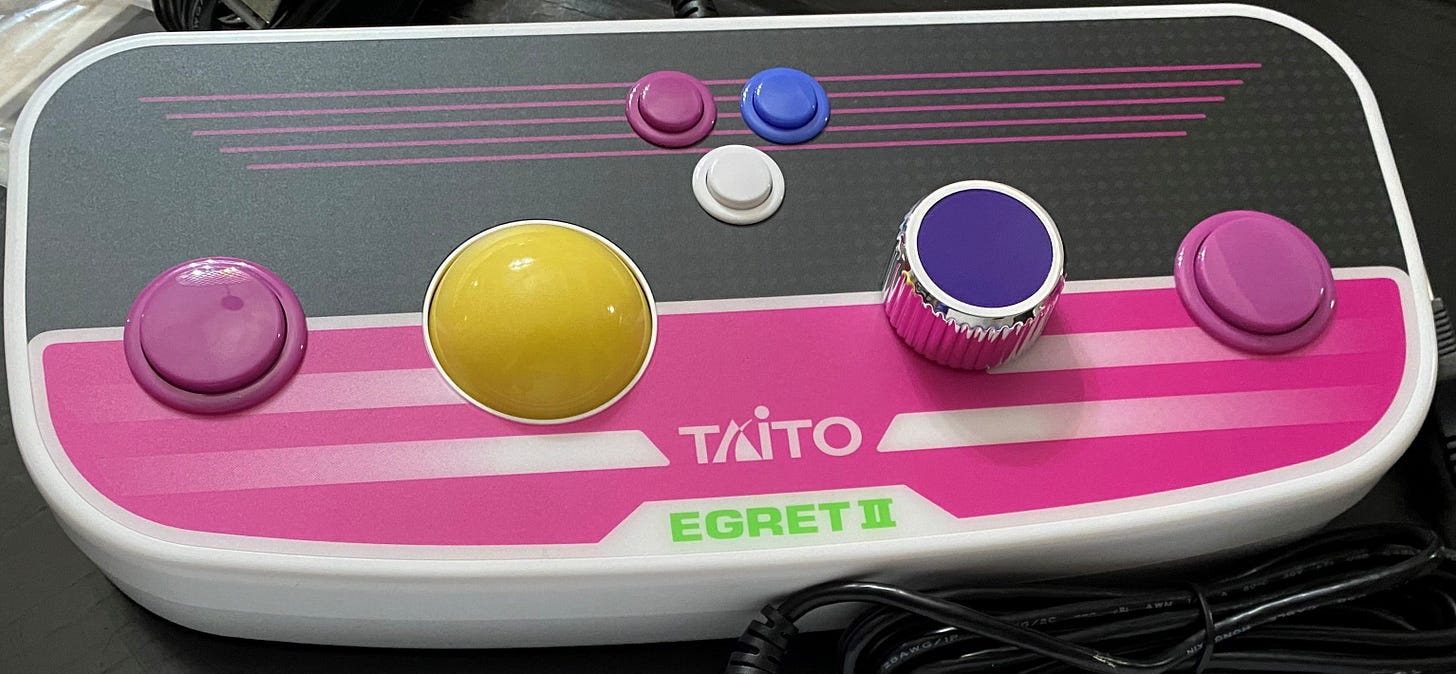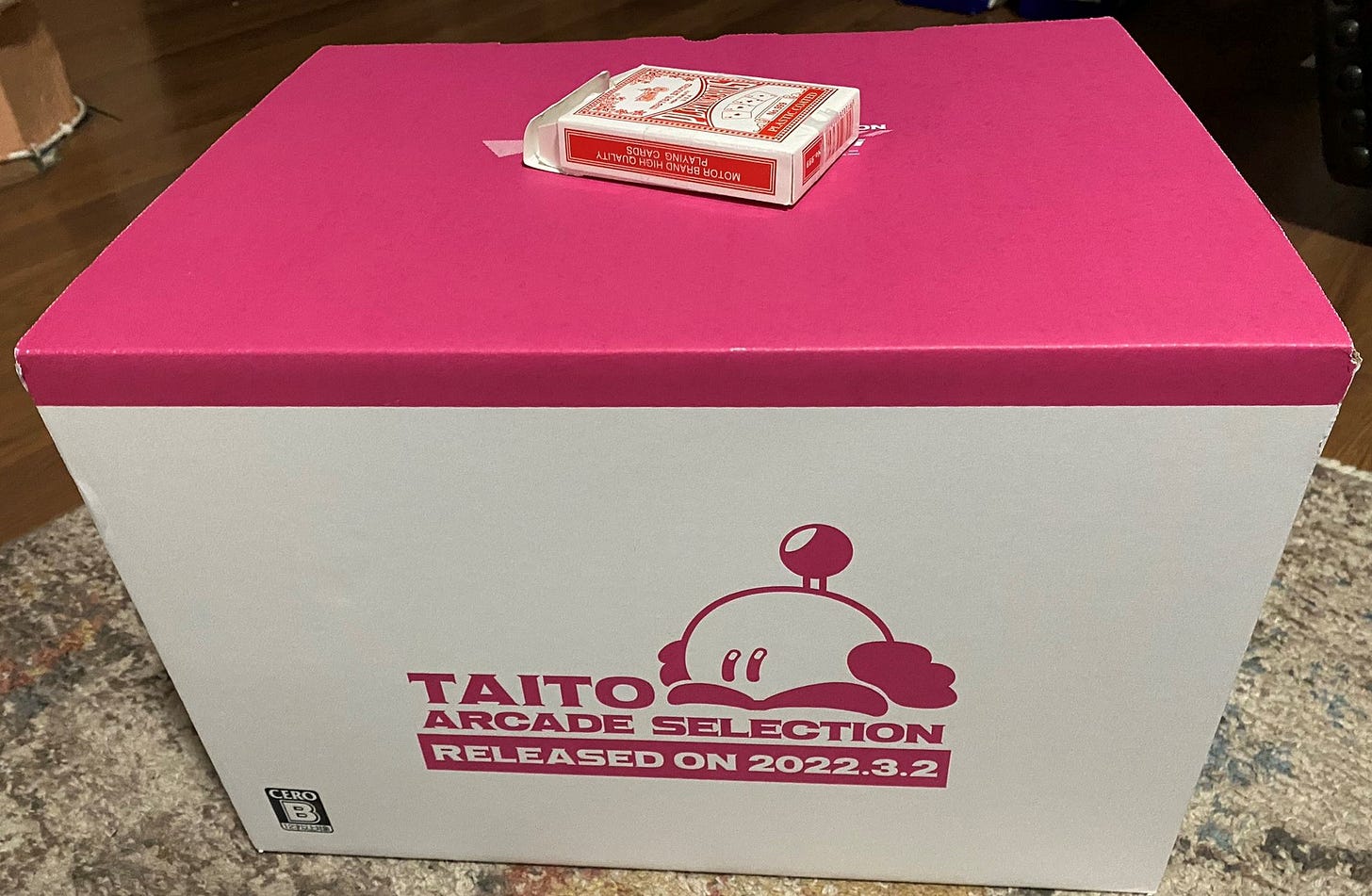Egret II Mini Review 2/2: Games and accessories
This begins the second part of my look at the Egret II Mini: see last time for my impressions on the toy arcade machine itself. This time we’re going to talk about the game lineup and the accessories, from the arcade stick to the paddle controller.
The game library
Today we don’t really think of Taito as a major— Square-Enix swallowed them up years ago— but they didn’t really go anywhere, or even stop producing games: they just went small. (I, for one, recommend Touhou Spell Bubble.)
So it’s easy to forget just how prolific the company was in the 80s and 90s. This is after all the Space Invaders company; they made their name in arcades, and Taito arcades are still all over Japan. So the arcade game catalog on the Egret II Mini is able to show off Taito at their very best.1
There aren’t really too many recognizable “names” in the Egret lineup: Space Invaders, Bubble Bobble and Darius are about it as far as “franchise” titles. There are, however, a lot of fun video games, if you’re interested in those.
The thing that hit me about these games as I played down the list is that they’ve got real personality. The guard dog bark in the primitive Lupin III.2 The aggressive mascot Sanrio-style cuteness of the platform games. The consistently unique, slightly off-kilter story text that introduces games like Rastan Saga and Violence Fight. The action-movie tough guy voice acting in Runark (aka GROWL). This is the good stuff.
In short, I find these games really approachable and charming. There are a few primitive games from the Space Invaders wave: Lunar Rescue is unusual, easy-going, and worth a try. You’ve got a lot of evolutionary relatives of Bubble Bobble, small-scale action platform games with cute characters. And you’ve got a lot of Taito’s signature shooters (along with a couple from Toaplan, as a treat), from the flagship title Darius Gaiden to the bleakly atmospheric Metal Black. Outliers like the multiplayer action-RPG Cadash, a 10-years-early version of Lemmings in Steel Worker, and “Pac-Man on a sci-fi bike” Raimais dot the lineup to offer some more variety. There’s even a fighting game— the little-known Kaiser Knuckle and its unreleased update Dan-Ku-Ga, which has a bit of a cult following since community players rediscovered it— to top it off.
These games are also arcade-tough. Every single one of these games is gleefully prepared to kill you within the first few minutes, so get ready for that. In addition to free play, you also have the benefit of save states. You’ll probably need them to beat these games.
The historical narrative
There’s also something of an implied historical narrative to this game selection, though it probably wasn’t intentional at all. Notice the variety of all these genres? Shooters, platformers, beat-em-ups, puzzles, even a couple of sports games on the list. Notice where they cut off? Around 1995. Notice what the very last game is? A (never-released beta) fighting game.
In 1995 fighting games were reaching full arcade saturation. Consider the major games that came out in this one year: Street Fighter Alpha, Virtua Fighter 2, King of Fighters 95.3 There was no holding back this tidal wave, and some these genres didn’t have a chance anymore! Elevator Action Returns is in particular among the last of its kind: a high-end, 2D arcade action platformer.
So to me, the Egret II Mini lineup illustrates a time when arcades had all kinds of video games, not just fighters and shooters. This is a bygone era too, even compared to the arcades that do exist today. Of course, fighting games are my favorite thing and you would think I shouldn’t complain, right? But Pac-Land is arcade, too. Shinobi. Bubble Bobble. Arkanoid. I’d like to see that kind of arcade return as well.
The games on here might not be famous, but I’ll take interesting over famous any day.4
Expandability
There’s an SD card slot on the side of the Egret II Mini for any expansions or patches the system might need in the future. I’m hoping for patches, as there are definitely things in the software that I’d like to change. The first expansion— a collection of trackball and dial-compatible games— launched with the system.
Accessories
Of course, you’re eventually going to want to play the games with standard controls, and that’s where the Egret starts to make its money. I bought the full package, so I have my pick between a game pad, a mini arcade stick, and a trackball/dial controller.
The game pad has a nice concave thumb pad that your thumb sinks right into, and six firm concave buttons similar to those on classic Nintendo controllers. If this pad had a pair of shoulder buttons, it’d be perfect for retro emulation. It’s still great for anything up to 16-bit.
Now the arcade stick is really interesting. Did you want a full arcade panel ripped off a real Egret? Well, here it is, crammed onto the absolute minimum of plastic necessary. This is a “mini” stick with full-size parts and the absolute minimum of room for your hands.
As, again, a big-handed guy, my hands hang off the edges of the mini-stick like my feet do when I’m sleeping in a bed I’m too tall for. At first I thought it was going to be impossible, but pretty quickly I was pulling off combos in Dan-Ku-Ga without any problems. Of course, as a serious fighting game player I’ll take a full size fight stick over this any time. It’s a cute novelty item, though, and like the main unit it can be switched to 4-direction mode.
And speaking of, Hori PS4 arcade sticks (I can’t test for other brands, but I can confirm your PS pads won’t work) are fully compatible with the Egret. All the buttons are mapped correctly, with Home/R3/L3 working for menu/coin/start. This wasn’t publicized at all— because I imagine Taito wanted to sell some of their own arcade sticks— but it’s extremely welcome.
The other controller is really out of the box: it’s a panel with a dial (or paddle) and trackball, for games that use these controls. This controller comes with an SD card that contains all the dial/trackball-compatible games, ranging from the Arkanoid series to unique oddities like Syvalion, a shooter where you navigate a mechanical space dragon through a maze with a trackball.
These are the kinds of games you really can’t play the “right” way without their specialized controllers: it’s just not the same game anymore. Both the trackball and the dial feel sturdy and high-quality, and the dial design itself— shining silver chrome and deep blue— is lovely. This panel is the same size as the mini arcade stick, but the parts are much smaller, so the space issue doesn’t come up.5
Unfortunately, the original Arkanoid (but not its sequels or other paddle games) seems to have some kind of weird lag problem: the ship just doesn’t move with the paddle like it should. Movements are unpredictable, and it doesn’t really feel like my fault when I miss the ball. Whether via the SD card or by some other means, this game needs a patch.
I’m discovering that, go figure, I’m very bad with these new control methods! It’s as though I haven’t been using them for 20 years, like with my arcade sticks. I actually love new control experiences, so it’s been a fun learning experience for me trying to, you know, not lose at Arkanoid.
Input lag and other issues
Bluntly, this ain’t a MISTer, nor is it original arcade hardware. The hardware is the same as in the Astro City Mini and in many other devices. You’re definitely getting a few frames of input lag here.
This isn’t a gap we’ll cross with these kinds of devices until there really is a FPGA in there, and you’re playing on an old CRT monitor. So probably never.
The rapid-fire option is also a problem that needs to be addressed with a patch along with the Arkanoid issue. Different games need different rapid-fire speeds to remain fun and fair, but the Egret II Mini software simply uses the same, fastest possible rate of fire. This button turns a lot of shooters, notably Kiki Kaikai and Metal Black, into cheating cakewalks.
The devs need to take a close look at each individual game and figure out a rate of fire that’s both fair to the player and true to the game’s intended design. Modern ports need auto-fire because nobody needs to break their fingers over a video game, but implemented badly like this, it just ruins the game.
The price of no compromise
I bought the full package; we’ll say this is because I love you all so much, but really it’s the price structure that pulled me up there.6
At first I only wanted the base unit, which is about 200-some shipped. But then there was the trackball expansion, a unique experience too good to turn down; that bundle was about 350. Then Amazon JP cut down the “everything” bundle— including, crucially, the arcade stick— to about $450.
I had to think about the difference between $350 and $450 and pledge, y’know, not to buy any new video games for a while, even Elden Ring, even Stranger of Paradise… and I pulled the trigger. Am I so old that my love for retro exceeds my desire to stay remotely current or relevant? Yes, probably. (Hire me today!)
Given what we now know about the mini’s controller compatibility, I’d say to go ahead and get the base unit or base+trackball bundle if you’ve got a Hori stick. It hurt my wallet bad (Hey, wanna subscribe to the newsletter? Have you seen my Ebay?), but I definitely don’t regret going all-in.
Multi-screen games like Darius I/II and The Ninja Warriors, probably the hardcore favorites, are out due to their bigness. Despite its deluxe cabinet and flight stick, the cyberpunk flying-car shooter Night Striker has been floated as a potential future add.
Lupin III has almost nothing to do with the anime character beyond the license: the character looks like leBlanc’s Arsene Lupin and none of the usual gang are on hand, unless you pretend those cops are Zenigata. Lupin III fans will, however, enjoy the dinky chip rendition of the famous theme song.
I would have loved to see Taito’s own Psychic Force on the Mini but alas, it’s a 3D PS1 game.
If I may ramble a bit: I’m always a bit disappointed in people when they decry retro releases that aren’t the same five games they always play over and over again. I get it: Super Metroid and Chrono Trigger and Symphony of the Night and Earthbound are all legit masterpieces.
But for me, a lot of the excitement of retro gaming is digging in the crates. It’s finding new stuff, like Dan-Ku-Ga, and taking in games I never got to try, like the arcade sequels to Bubble Bobble. So if someone says, “Adventure Canoe? What the hell is Adventure Canoe?” I want to say, yes, exactly, why don’t we try it.
And of course, this is going to be a killer accessory for emulation.
I sold a very expensive Jojo’s Bizarre Adventure T-shirt to afford the full package.
